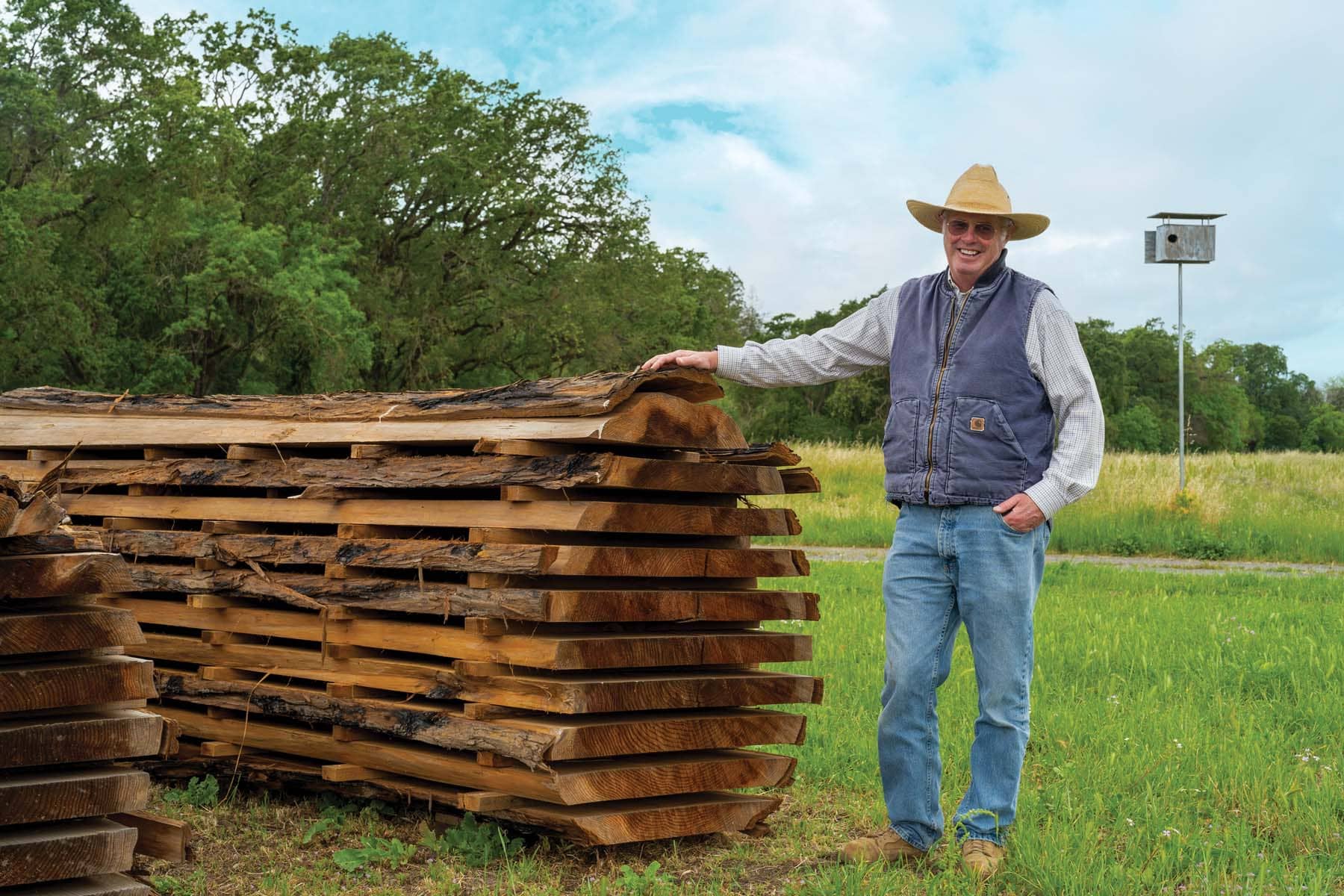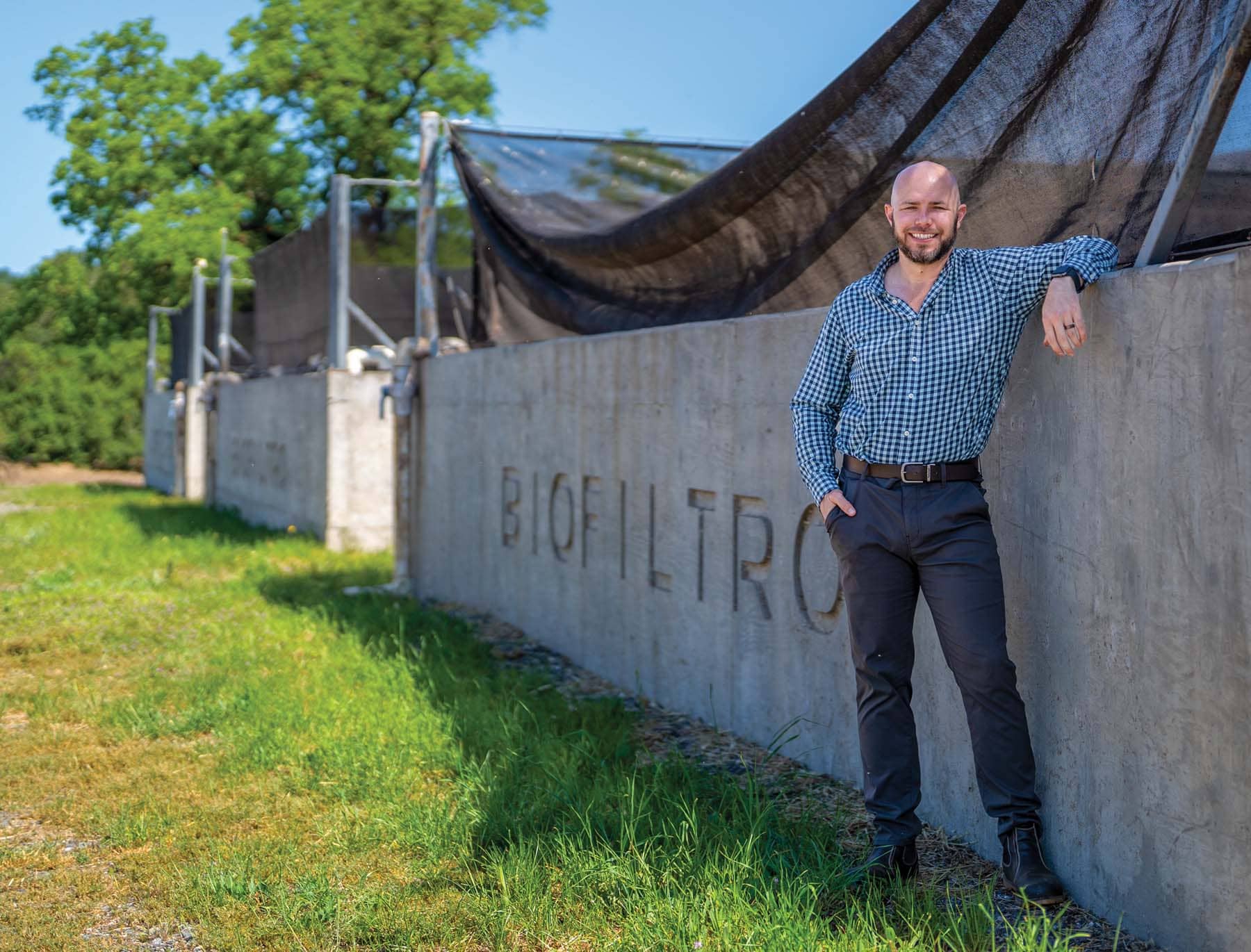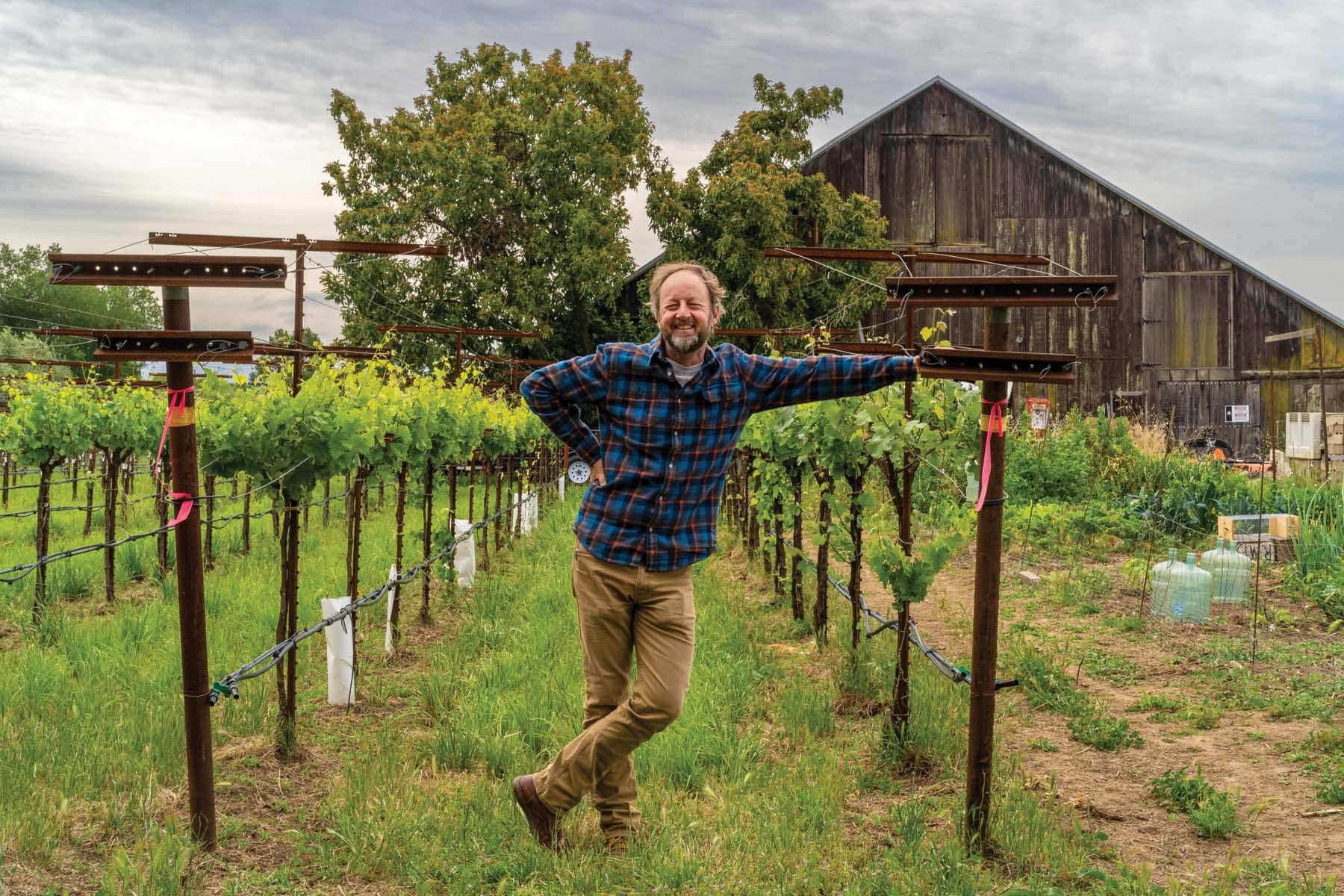
The proponents of regenerative-organic viticulture claim everything from improved quality and reduced farming costs to helping slow the rate of global climate change. And although few, if any, voices actively denounce such practices, plenty of farmers are still on the fence as they wait for more evidence before committing their time and resources toward yet another new approach to growing wine grapes.
For those souls already committed, however, regenerative organic farming is not only smart business—it’s also the right thing to do. “Regenerative organic viticulture is a holistic approach that goes beyond organics to include caring for the land and water, creating healthy habitats, sequestering carbon and caring for the well-being of all those involved in the process,” says Steve Matthiasson, owner and winemaker at Matthiasson Wines in the Napa Valley.
Matthiasson is working toward becoming one of the first Napa Valley vineyard owners to receive a Regenerative Organic Alliance (ROA) certification. Launched in 2017, ROA is largely considered at the forefront of regenerative agricultural practice certification.
Regenerative farming
What exactly is regenerative farming? In the past 70 years, viticulture (and agriculture more generally) has transformed from a relatively natural process — dependent on being intimately synchronized with nature — into a super-charged industry that quickly became mechanized and dependent on synthetic chemical fertilizers, herbicides and pest control products. The initial upside of the change was that by the mid-20th century production levels had increased. The downside was that over time — in what amounted to a negative feedback loop—soils and crops subjected to such unnatural inputs often became more vulnerable to disease, extreme weather events and other stressors.
As early as the mid-20th century some farmers and scientists began to sound the alarm, suggesting that without reducing our reliance on chemicals and machines and adopting more natural approaches to farming, eventually crop health and quality would decline and human health would be compromised.
In 1962, Rachel Carson published Silent Spring, a book that highlighted the dangers of synthetic pesticides. The book brought an issue that had largely been hidden into the public dialogue. Fewer than 10 years later, in 1970 the Environmental Protection Agency was created to assess and remedy growing concerns over pollution and the application of synthetic chemicals.
Prior to when Carson was contemplating how the world might end up if our use of harsh chemicals continued, environmental-activist farmers such as Rudolf Steiner and Wendell Erdman Berry advocated for the use of more natural farming methods.
By the 1980s, Robert Rodale had coined the term “regenerative organic agriculture” as a way to describe the integration of numerous natural techniques that essentially reduced or eliminated the need for mechanical or synthetic forms of farming.

The Gamble family has been active in both regenerative practices and environmental advocacy in the Napa Valley, helping to establish the Napa County Agricultural Preserve in 1968. This limited unconstrained growth and allowed land to be set aside for agriculture.
“If it weren’t for the Ag Preserve, I don’t know if the Napa Valley and its wine industry would be what it is today,” says Gamble. “Without it, this entire valley would have likely been paved over—like Silicon Valley.”
Today, the Gambles actively work toward the Regenerative Organic Certification (ROC), restoring more than a mile of the Napa River, and they recently launched an effort to plant more than 1 million trees within the county in the coming years. “It’s critically important that our lands are farmed in a manner that is sustainable for generations to come,” he says, “improving the resiliency and health of the soil, while at the same time sequestering greenhouse-gas carbon dioxide (CO2) emissions to help moderate climate change.”
A Seventh-Generation philosophy
The Iroquois people (Haudenosaunee) have what is known as the Seventh-Generation philosophy. The idea is that although it is important to adapt and change to evolving conditions and not be frozen in the past, it’s equally important that practices and traditions should be focused on the security and health of future generations.
For many, such a philosophy is almost unthinkable in modern times, when many are focused on much shorter time horizons. However, grapevines are perennials that can have lifespans of more than 100-plus years and are some of the oldest agricultural crops in history. They have been farmed for thousands of years, and there is a growing realization that viticulture has a special role in helping refine and define regenerative organic agriculture practices.
The vineyard of the future
In many regards, the vineyard of the future may resemble ancient vineyards of the past. But look more closely at these new interpretations and you’ll often see high-tech gadgets and creative bio-processing contraptions at work behind the scenes. Take, for example, Fetzer Vineyards, based in Hopland. They were one of the first vineyard operations to become ROC-certified in the state. Today, Fetzer Vineyards’ flagship organic brand, Bonterra Organic Vineyards, and their general vineyard farming practices stand on the cutting edge, employing strategies that even a few years ago were either unavailable or unimaginable.

“It’s a complete water loop—from the vineyard to the grape to the winery and then back again,” says Nelson. “Not only do we recycle and reuse the water, but we also use about 50% less energy when it comes to processing the waste. So it’s not only the right thing to do, it’s also the smart thing to do.”
Beyond innovative water conservation, the Fetzer Vineyards organization is also looking toward vineyard practices that will extend a vineyard’s life horizon.
“The days of churn-and-burn vineyard management are over,” says Nelson. “Instead of looking to replace a vineyard every 20 years or so, now it’s important to have much longer time horizons. Thinking more in terms of generations will allow the entire industry to be more thoughtful and proactive when it comes to building a sustainable future.”
Part of the proactiveness of regenerative farming is anticipating how to address a changing climate, which is predicted to create warmer and dryer conditions.
“Back in the 1970s very few in the industry were even thinking that the climate might change as much as it has,” says Nelson. “But whereas some of our Mendocino vineyards might have been perfect back then for Merlot or Chardonnay planted on non-drought-resistant rootstock, today that’s changed, and we need to take that into consideration with every decision we make.”
To address such changes, Nelson and his team are looking to plant more heat-tolerant varieties such as Cabernet Sauvignon and Sauvignon Blanc, while at the same time looking toward water-seeking rootstocks that can thrive under even the harshest drought conditions.
This shift in varietals and rootstocks is not limited to Fetzer Vineyards. Most California wine-grape growers are actively anticipating that droughts and higher temperatures will continue to influence their choices.

“The two most important aspects of regenerative farming are the health and quality of both the soil and the people tending the vines,” says Camarena. “It’s important that you plant the right variety on the right rootstock at the right place and in the right way. There’s both art and science that goes into it. These experiments will allow us to continue to produce excellent wine, no matter how things change.”
Another key aspect of regenerative farming is the use of cutting-edge technology. Beyond using biological-inspired processes such as the worm beds at Fetzer Vineyards, nearly all regenerative advocates also actively deploy everything from well-established soil moister probes and real-time weather stations to more experimental contraptions, such as powdery mildew spore trappers that help vineyardists determine exactly when to spray for mildew.
“Because mildew is the biggest threat in the vineyard and because you can’t see it before it’s too late, historically we’ve been forced to spray entire vineyards multiple times each year,” says Matthiasson. “The spore-trapping technology is brand-new, but the promise is huge. I mean, what if you could determine exactly where and when to spray? That would not only save significant costs but also greatly reduce the amount of sulphur and other sprays used. It’s a big, big deal.”
Carbon sequestration
Using fossil-fuel-derived power and synthetic chemical applications of fertilizers, herbicides and pest controls, a conventionally farmed vineyard typically emits more carbon than the plants in the vineyard can consume. One of the goals of regenerative organic agriculture is to create conditions where the vineyard actually consumes and holds (sequesters) more carbon than it emits, while at the same time reducing the amount of carbon expelled.
The body of the plants are made of carbon, vine wood and cover crops such as grasses and their roots that sequester carbon. Therefore, allowing for permanent overcrop has a twofold effect. First, the plants and roots draw in carbon and hold it in place, while at the same time less carbon is emitted by not needing to use a tractor to till the rows.
Beyond sequestration, not tilling improves biodiversity (microbes, fungi mycelium networks, helpful invertebrate communities), allows for greater water absorption and helps retention and nutrient dispersal.
According to Gamble, permanent cover-crop strategies can sequester tons of additional carbon per year per acre and also reduce costs associated with fuel and labor.
The future of grape farming
Before regenerative organic farming, grape farmers were encouraged to adopt organic, sustainable or biodynamic practices. With a host of organizations offering such advice and certifications, many farmers—and certainly consumers—remain confused about the difference between having a certification from the California Sustainable Winegrowing Alliance, LODI RULES, SIP Certified, Napa Green Vineyard, Sonoma County Sustainable Winegrowing, LIVE in Oregon or Long Island Sustainable Winegrowing in New York and probably others. While each of them is worthy in their own right, today, however, a Regenerative Organic certification from the Regenerative Organic Alliance is fast becoming the gold standard for vineyardists and the broader agricultural community more generally.
Although many aspects of regenerative farming might appear familiar to vineyardists who were living 200 years ago — non-tilled vine rows, sheep and goats deployed as weed control agents, and hand-tended vines — plenty of today’s practices would seem unimaginable. Using water probes, spore traps, weather stations and laboratory samples of everything from soil to grape skins, modern grape-growers look to have one foot in the future and one foot in the past. Regardless of where their feet might be metaphorically, however, both feet are typically firmly planted in the soil, right alongside the vines.

Synthetic Fertilizers
Gas-powered tractors were first invented in 1892 but rarely used in vineyards until the 1920s, with farmers plowing the land either by hand or using a horse and plow. After World War II, during the 1940s, synthetic fertilizers became widely available, and their application fast became standard viticultural practice. At about that same time, two herbicides hit the market: 2, 4-dichlorophenoxyacetic acid (known as 2,4-D) and 2,4,5- trichlorophenoxyacetic acid (known as 2,4,5-T).
These two chemicals would eventually be combined to create Agent Orange, a powerful defoliant used in the jungles during the Vietnam War to eliminate plant growth that might hide the enemy. A byproduct found in both 2,4-D and 2,4,5-T—dioxin—was found to negatively impact the health of animals and humans, causing cancer, reproductive and developmental problems, damage to the immune system and hormone regulation. By the early 1970s such health concerns resulted in the development of a new alternative herbicide that would eventually become known as Roundup. First introduced in 1974, Roundup (a glyphosate-based herbicide) was completely unlike the earlier options and initially believed harmless to anything other than the plants onto which it was applied.
The enzyme glyphosate is a protein only found in plants and not in animals and humans, so initially it was believed that applying it would have no negative health impacts. The product was considered so safe that the Monsanto scientists who invented it were fond of claiming that drinking Roundup was harmless. The result was that Roundup fast became the most widely used herbicide on the planet. Then in the mid-1990s, when the patent for Roundup was ending, Monsanto came up with a brilliant new idea. Because glyphosate was an indiscriminate herbicide — that is, it killed any plant to which it was applied — researchers created genetically modified seeds for crops such as corn and soybeans that were essentially immune to the Roundup. The result was that farmers could plant their crops and then spray them throughout the year to kill the unwanted weeds, while having no effect on the crops themselves. This was a boon for Monsanto — which could now sell both the seeds and also the Roundup. The result? The worldwide application of Roundup skyrocketed. A 2017 study found that Americans ‘exposure to glyphosate had increased roughly 500% since the so-called “Roundup Ready” genetically-modified, glyphosate-tolerant crops were first introduced in 1996. Unfortunately, studies are now showing that glyphosate is not as harmless as was once believed and is now being correlated with cancers and liver and kidney damage.
Although there are no “Roundup Ready” grapevines because vines go dormant during the winter months, using glyphosate became a normal practice for many grape farmers who sprayed to keep weeds at bay during late winter or early spring before bud break.
Rootstocks and Phylloxera
By 1889, fueled by new money from the gold rush and a growing public interest in wine, a mass influx of immigrants to Northern California had begun planting vineyards and building wineries. In the Napa Valley alone, nearly 200 wineries and 18,000 planted acres of wine grapes carpeted the valley floor. Today in the Napa Valley, 46,000 acres are planted in grapes with well over 500 physical wineries (more than 1,600 if you include “virtual” wineries).
Sonoma has a similar story. However, by the end of the 1800s, the rapid growth slowed after a series of financial downturns and a shift in consumer preferences away from alcohol. Soon after, a tiny sap-sucking root louse called phylloxera — originally transported on cuttings from the East Coast of the United States to Europe, where it decimated vineyards in France, Germany and Italy and then found its way to California. The result was that the vast majority of vineyards withered with most of the majority of wineries left abandoned. By 1905 only a handful of functioning wineries and only a few thousand planted acres of wine grapes remained.
Time passed. Slowly vineyards and wineries multiplied and with innovative rootstocks such as AxR-1 new vineyards were widely planted in the 1970s. The rootstock AxR-1 initially protected the vines from phylloxera, but that was to change as the tiny sap-suckers rapidly evolved. Up until that time AxR-1 had seemed miraculous. Not only did it protect the vines from pests, but it was also a “high-vigor” rootstock that had the ability to find and transport water from deep in the soil. Vineyard owners were thrilled with the results — large, healthy crops that brought in large profits.
By 1983, though, AXR-1’s resistance to phylloxera was all but over. Thousands of vineyards had to be ripped out, and hundreds of vineyard owners were left bankrupt or forced to replant. From that aftermath, a new mantra of California grape-growing emerged. It was the mid-1980s, and whereas quantity had been the driving goal of earlier wine-grape growers, quality now became valued as consumers were willing to pay handsomely for wines from around the world as well as those grown in California.
The result was that many NorCal vineyard owners of the late 1980s shifted from high-vigor rootstocks toward “low-vigor” rootstocks that had shallower roots. These rootstocks protected against phylloxera, but the key benefit was that water could be restricted at key moments of the yearly growth cycle to “stress” the grapevines into producing small clusters of intensely flavored grapes. Because the roots were unable to find scarce water on their own, they were made dependent on drip irrigation and so were at risk when subjected to drought conditions.
Fast-forward to today, when many new vineyards are being planted with “drought-resistant” rootstocks (aka, high-vigor, like AxR-1 had been) such as 110R and 1103. Because these rootstocks can locate water sources deep underground, many winemakers believe that wines of the future may resemble those made when AxR-1 was more dominant, which made wines that were delicious in their own right but certainly not as concentrated or darkly colored as those of the more recent past.
[Lead photo by Tim Carl Photography]
Author
-

Tim Carl lives, writes and teaches in Calistoga. He grew up in St. Helena and traces his Calistoga grape-growing roots back five generations. You can reach him at tcarl@northbaybiz.com.
View all posts



